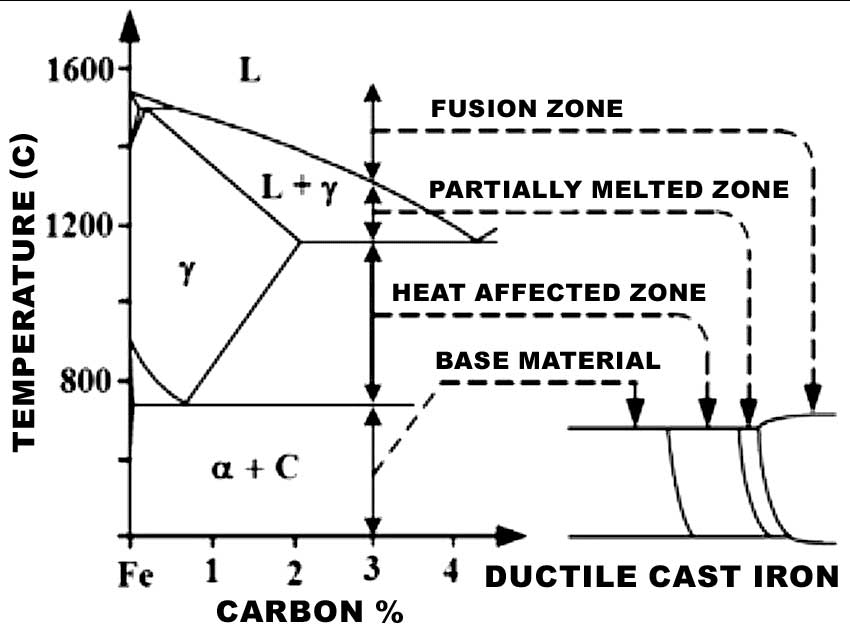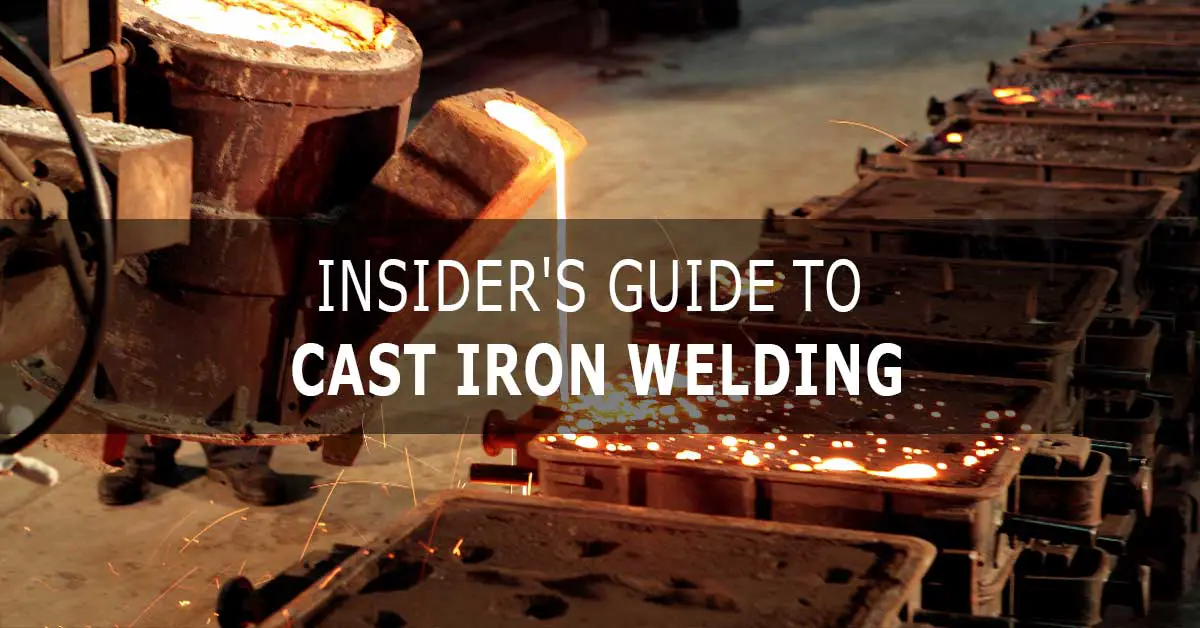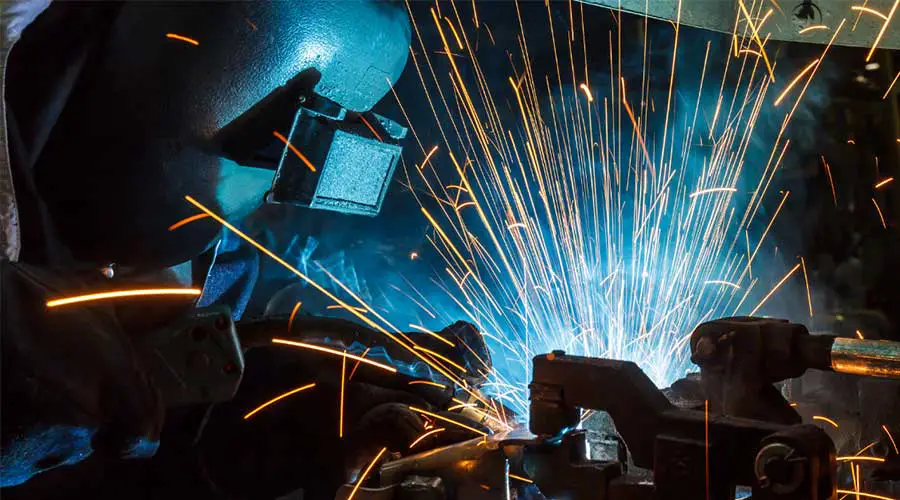Cast iron welding is challenging and associated with many technical tips and tricks; however, it is not impossible and can be successful if we follow a proper procedure.
Typically, welding cast iron takes place for repair jobs of defects that arise during operation and for repairs of post-production whenever defects were discovered after casting operations and subsequent machining processes.
Cast iron is a common term of ferrous alloys containing more than 2% carbon content and 1-3% silicon content, as well as phosphorous and sulfur.
Roughly, cast iron contains ten times more carbon than most steel. Alloys of cast iron may have other added elements to have the desired properties of strength, hardness, hardenability, and corrosion resistance. These elements commonly added to cast iron alloys are chromium, copper, molybdenum, and nickel.
Types of Cast Iron
There are four basic types of cast iron:
- White cast iron.
- Grey cast iron.
- Malleable cast iron.
- Ductile cast iron.
In addition to compacted graphite cast iron (CG), which is the fifth type of cast iron but not standardized, CG cast iron has an intermediate microstructure between grey and ductile cast irons.
The main difference between the different types of cast irons is the form of carbon in the alloy; the carbon may present as combined carbon such as in carbides, separate, or free graphite. The shape, size, and distribution of graphite present in the alloy matrix affect the mechanical properties of strength and hardness.
The different types of cast irons have differences in chemical composition, as shown in the table, the chemical composition ranges for typical un-alloyed cast irons.
| Range of compositions for typical unalloyed cast irons | |||||
| Cast iron | carbon % | silicon % | manganese % | sulfur % | phosphorus % |
| White | 1.8-3.6 | 0.5-1.9 | 0.25-0.8 | 0.06-0.2 | 0.06-0.2 |
| Malleable | 2.2-2.9 | 0.9-1.9 | 0.15-1.2 | 0.02-0.2 | 0.02-0.2 |
| Gray | 2.5-4.0 | 1.0-3.0 | 0.2-1.0 | 0.02-0.25 | 0.02-1.0 |
| Ductile | 3.0-4.0 | 1.8-2.8 | 0.1-1.0 | 0.01-0.03 | 0.01-0.1 |
| Compacted graphite | 2.5-4.0 | 1.0-3.0 | 0.2-1.0 | 0.01-0.03 | 0.01-0.1 |
1. White cast iron
White cast iron is formed when carbon combines with iron, chromium, molybdenum as carbides and does not precipitate as graphite during solidification; that is why this white cast iron is tough and brittle. White cast iron is not weldable due to the absence of adequate ductility, which is required in welding to accommodate the thermal stresses in the base metal.
White cast iron is commonly used in applications requiring good hardness and abrasion resistance, such as the wear surfaces (impeller and volute) of slurry pumps, shell liners and lifter bars in ball mills and autogenous grinding mills, balls and rings in coal pulverizes, and the teeth of a backhoe’s digging bucket.
2. Gray cast iron
Grey cast irons are iron-carbon-silicon alloys having uncombined carbon in the form of graphite flakes; these iron-carbon-silicon alloys are named grey cast irons due to the grey appearance of fractured surfaces of these alloys. Copper, chromium, molybdenum, and nickel are added to these alloys to control matrix microstructure and graphite formation and also to improve corrosion resistance.
Grey cast irons lack ductility because of the flake form of the graphite where graphite has virtually no strength, so numerous flakes create internal notches in the steel matrix that is why fracture can initiate easily from these notches and progress rapidly without plastic strain.
Grey cast iron is commonly used in machinery and automotive industries like brake drums, clutch plates, and various other automotive parts.
3. Malleable cast iron
Malleable cast iron is formed by heat-treating white cast irons of suitable compositions, which are promoted when the following conditions are fulfilled:
- Low carbon and low silicon content in the alloy.
- The presence of carbide forming elements in the alloy like chromium and molybdenum.
- Rapid solidification and cooling of the alloy.
Heat treating of white cast iron to produce malleable cast iron is performed by heating cast iron above eutectoid temperature, which is usually 927 °C (1700 °F) in a controlled atmosphere in the furnace and held for several hours where this treatment permits the carbon to dissolve in austenite to precipitate as irregular nodules of graphite which are known as temper carbon.
As a consequence of the slow cooling process, a ferritic matrix is produced surrounding the formed temper carbon. Also, a pearlitic or martensitic matrix can be obtained by alloying or by air or liquid quenching from the austenitizing temperature and these two structures are tempered after quenching. Therefore, the mechanical properties of strength and ductility depend mainly on the metallurgical structure of the matrix by being ferritic, pearlitic or martensitic and also the distribution of free carbon in the matrix.
When comparing the mechanical properties of grey cast iron and malleable cast iron, the malleable cast iron shows some improvement in mechanical properties and this is due to the shape of free graphite where the nodules in malleable iron give good mechanical properties rather than the flakes in the case of grey cast iron, which represents as a sharp internal notch.
Malleable cast iron is commonly used in many applications, including flanges, pipe fittings and valve parts, automotive parts like steering components, compressor crankshafts, hubs, transmission, and universal joints where the proper specification covers each application.
4. Ductile cast iron
Ductile cast iron and grey cast iron are similar in carbon and silicon contents. Still, in the case of ductile cast iron, the graphite is present in the alloy matrix as nodules rather than as flakes in grey cast iron which form sharp internal edges resulting in lower mechanical properties relative to that of ductile cast iron. Spheroidization or nodulization of graphite can be achieved by introducing magnesium or cerium to low sulfur melt, which is preferably to be lower than 0.02% that can be achieved by adding calcium oxide, calcium carbide, or sodium carbonate to the molten metal.
Due to the nature of magnesium of lower vaporization temperature, magnesium may be introduced to the molten metal as an alloy of magnesium combined with one or more elements of nickel, silicon, iron, and calcium. A residual concentration of 0.035% is required to have complete spheroidization; that is why during welding of ductile cast iron, we have to select the process of lower heat input to have a low time in the molten state as possible to decrease magnesium vaporization and consequently decreasing material graphite degradation.
Ductile cast iron is commonly used in casting sewer and pressure pipes, fittings, valves, and pumps.
5. Compacted graphite cast iron
Compacted graphite cast iron is produced in the same way as ductile cast iron but with more control on magnesium addition to the melt and graphite take a form in between that of ductile cast iron and grey cast iron where graphite is in the form of irregular shapes, not flakes or spheroids. Therefore, compacted graphite cast iron can achieve a mix of mechanical properties between ductile and gray cast irons.
Welding cast iron tips and tricks
All types of cast iron except white cast iron are weldable but with a degree lower than steel. Welding can be done by using different welding processes: oxy-fuel welding (OFW), shielded metal arc welding (SMAW), flux-cored arc welding (FCAW), gas metal arc welding (GMAW), and gas tungsten arc welding (GTAW). Common filler metals are iron-based or nickel-based electrodes and rods to produce high-quality welds.
Cast iron welding considerations
During cast iron welding, the main points to consider for sound weld are metallurgical considerations, strength considerations, base metal preparation, welding variables, and welding filler metal. We will explore all these considerations one-by-one.
1. Cast iron welding metallurgical considerations
A. Heat affected zone
The high carbon content of cast irons represents a big challenge, affecting cast iron weldability. During manufacturing process, it becomes possible to produce microstructures having useful mechanical properties. However, welding cast iron is characterized by rapid cooling rates compared to manufacturing process. Therefore, during welding, undesirable microstructures are produced in the heat-affected zone, as shown in the below figure.

During welding, the heat-affected zone (HAZ) is heated to a temperature near the melting point. The cooling rate of weld metal and HAZ is very rapid, resulting in carbides formation in HAZ; besides, the high temperature and high carbon content of HAZ allows carbon to diffuse to austenite (base metal phase at this temperature) which upon cooling it forms high-carbon martensite structure. Martensite structures consisting of cementite and martensite, that are brittle and cause cracking either upon welding completion or during service.
Arc welding produces thermal cycles in the welding area and consequently produces stresses, so the base metal shall have some ductility to accommodate these stresses.
Welding is done by using approved welding procedures in which the following factors are considered to accommodate the thermal stresses to avoid cracking:
- Preheat and post heat.
- Welding sequence: back step, cascade, block, and intermittent welding.
- Minimizing weld pool dilution to lower limit, as much as possible.
- Inter-pass peening.
B. Partially melted zone
The partially melted zone is the area of base metal adjacent to the fusion line, which is partially melted. The melted portion becomes like the molten cast iron in a eutectic reaction, as shown in the zones figure above. The typical rapid welding cooling forms white cast iron, and a complex structure of austenite and martensite, primary carbide, and ledeburite are produced. Therefore, this zone is the hardest zone in the weldment joint.
C. Fusion zone
The microstructure and mechanical properties of produced weld metal in the fusion zone depend mainly on the selected filler metal and the filler metal’s dilution percentage with the base metal.
Graphite form – As previously discussed, the graphite form in the different types of cast iron is different and affects mainly weldability. When carbon presences as graphite spheroids like the case of ductile cast iron or presences as symmetrical graphite rosettes like the case of malleable cast iron. Both forms of graphite will have improved weldability over the cast irons having graphite in the form of flakes like the case of grey cast iron.
2. Cast iron welding strength considerations
The strength of all weld metals is the indicator for the transverse joint strength, and this depends mainly on the filler metal used in welding.
3. Cast iron base metal preparation
Welding shall be done on well-cleaned surfaces free from oil, grease, and residual surface graphite, which mainly appears as casting skin on the casted products. The residual graphite inhibits the wetting of weld metal with base metal and must be removed before welding to ensure complete fusion and joining of the weld parts.
Any of the following ways can prepare cast iron workpiece surfaces:
- Electrochemical cleaning operation, using catalyzed molten melt operating at 455-510°C in a steel tank.
- Abrasive blasting, with steel shots, which is suitable for preparing surfaces of ductile and malleable cast iron.
- Exposing the surfaces to be welded to oxidizing flame or heating, the parts to be welded to 900°C in a strangely decarburizing atmosphere.
4. Cast iron welding variables
There are some variables to be considered during welding to reduce the produced thermal stresses and consequently decrease the possibility for crack propagation; these variables are as follow:
- Preheat.
- Peening.
- Post weld heat treatment.
A. Preheat
The preheating of the weldment joint before welding can slow down the cooling rate. The slow cooling rate becomes very beneficial in limiting the hardness of HAZ, especially by slow cooling of the welded joint after cooling. Besides, preheating leaves compression stresses in the welded joints after cooling down. The compression stresses are very beneficial in preventing cracking, whether during cooling or when the workpiece is in service, as shown in the following figure.
B. Peening
Peening is a mechanical work on weld passes that can release stresses, decrease distortion, and prevent HAZ cracking. Peening is done by using small hammers and is applied between welding passes.
C. Post weld heat treatment
Post weld heat treatment is performed mainly after welding to achieve the following enhancements:
- Improve the ductility of HAZ.
- Improve machinability of weld metal and HAZ.
- Decompose the formed cementite during welding.
- Relieve all residual stresses due to welding.
Each cast iron type has its typical post-weld heat treatment requirements, showing the heating temperatures required, hold time, and cooling rates after post-weld heat treatment.
Stress relief: the stress relief treatment is performed immediately after welding by raising the cast piece temperature to the range 590-620°C and holding at that temperature (soaking temperature) for 1Hr/inch (thickness of weldment joint), then cooling down to temperature 370°C by a rate not exceeding the rates specified in the followed standard. The stress relief process causes a slight reduction in hardness as carbides are stable at 590°C.
Full anneal: full annealing is similar to stress relief, but the soaking temperature is higher, around 900°C, and held for a suitable time to dissolve all formed carbides during welding then followed by cooling to 315°C by rates not exceeding rates specified in the followed standard. The full anneal process results in maximum softening and stress-relief and may cause strength reduction, which shall be considered before selecting this process.
Ferritizing anneal: Ferritizing anneal is performed immediately after welding, where the cast piece is placed into a hot furnace at a temperature range of 590-650°C for some time. The furnace temperature is then raised to 900°C and held for 2-4 Hrs. Then cooled down to 690°C and held for 5 Hrs. and then cooled to 590°C in the furnace. The workpiece is then cooled down to room temperature in a furnace or still air.
5. Cast iron welding filler metal
The selection of filler metal depends mainly on the type of cast iron to be welded, the desired properties of the welded joint, and economic considerations.
Filler metals are classified into two main groups:
- Iron-based filler metals.
- Nickel-based filler metals.
A. Cast iron “Iron-based” filler metals
The iron-based filler metals (electrodes) are mainly used by the shielded metal arc welding process (SMAW), and have the following categories:
Class ECI: these electrodes consist of cast iron core, which is why it is named ECI (Electrode – Cast Iron) and is mainly used for welding grey cast iron; however, Class ECI electrodes are not suitable for welding ductile and malleable cast iron.
Class ESt (Castarc): these electrodes have a steel core and graphite coating. These electrodes cause high stresses in the welded joint as the shrinkage of steel is higher than that of cast iron. Therefore, clast ESt electrodes are used mainly in welding repair jobs.
Low hydrogen electrodes have a basic coating with steel core like E7018, E7016, and E7018. Due to dilution with the cast iron base metal, the first pass will have high carbon content like high carbon steel, which is hard and brittle. Therefore, low hydrogen electrodes are limited to cosmetic repairs in nonstructural jobs.
Stainless steel electrodes: they are rarely used due to the formation of chromium carbides. Besides, the electrodes cause cracking due to differences in strength and coefficient of expansion. E308, E309, E310, and E312 are common electrodes that can be used.
B. Cast iron “Nickel-based” filler metals
Nickel-based filler metals are widely used in welding grey, ductile, and malleable cast iron. Still, they shall be used with control on dilution to prevent cracking as the solubility of carbon in nickel is low (0.02%). Therefore, if there is much dilution, there will be a high percentage of carbon in the adjacent weld metal, which upon cooling will cause cracking due to limited solubility.
ENi-CI, ENiFe-CI, ENiFeT3-CI, and ERNiFeMn-CI are common Nickel-based filler metals.
Cast Iron welding electrode based on welding processes
Many welding processes are used in welding cast iron: shielded metal arc welding SMAW, gas metal arc welding GMAW, submerged arc welding (SAW), and tungsten inert gas welding TIG.
Cast iron shielded metal arc welding [SMAW] rods
As mentioned before, there are a variety of SMAW electrodes used, either iron-based or nickel-based electrodes. SMAW electrodes are classified as per AWS A5.15 (Specification for Welding Electrodes and Rods for Cast Iron).
ENiFe-CI electrodes are preferred over ENi-CI due to the following advantages:
- Stronger and ductile weld metal is produced.
- More tolerable to phosphorous content.
- Prevent fusion line cracking as the coefficient of expansion of diluted weld metal.
- Less expensive than ENi-CI electrodes.
Cast iron flux-cored arc welding [FCAW] wires
There are two main wires used in this process: ERNiFeT3-CI and ERNiFe-CI, and they are very similar except that ERNiFeT3-CI has manganese content in the range of 3-5% to prevent hot cracking and improve the strength and ductility of weld metal.
Gas metal arc welding [GMAW] wires
GMAW welding of cast iron is lately going by using ERNiFeMn-CI welding wires other than using ERNi-CI wires due to the elimination of preheating need, so they become more economical.
Gas tungsten arc welding [GTAW] rods
The same filler wires used for GMAW can be used for GTAW, but wires will be in the form of rods with length 1000 mm length instead of coils in GMAW.
Submerged arc welding [SAW] consumables
ERNiFeMn-CI and ENiFeT3-CI are commonly used in SAW with flux powder INCOFLUX6.
References:
- AWS Welding Handbook. “Materials and Applications.
- Campbell, J., J. T. Svidró, and J. Svidró. “Molding and Casting Processes ASM Handbook Volume 1A: Cast Iron Science and Technology”.









